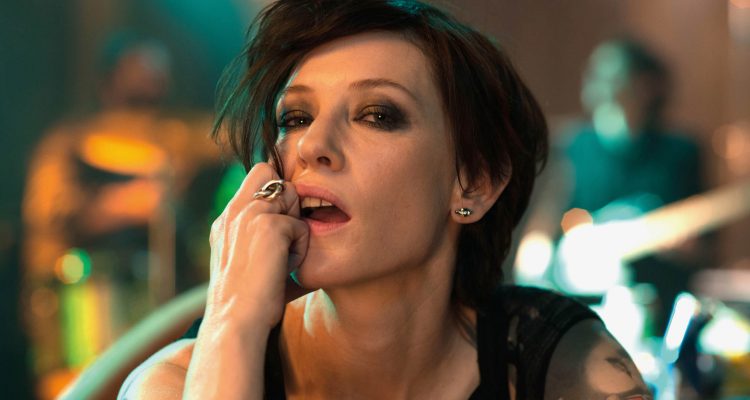So far during her movie career, Cate Blanchett has done uncanny imitations of Katharine Hepburn and Bob Dylan, and has played characters ranging from queens to elves to identical cousins. But she’s never made a film quite like “Manifesto.” Stitched together from a gallery installation by artist/filmmaker Julian Rosefeldt, “Manifesto” sees Blanchett playing 13 different characters — with 13 different accents — in a series of tableaux that have her reciting passages from various fiery old artistic declarations of principles, from the Dadaists to Dogme 95. Rosefeldt’s visual panache and Blanchett’s astonishing versatility bring cinematic verve to something that could’ve easily come off as too dryly conceptual.
 In their original form, the various pieces of “Manifesto” were placed on separate screens, in close proximity to each other. They were essentially complete films in and of themselves, but with segments that synched up and harmonized within the gallery space. The feature version mostly just strings those same shorts together, one after another, although occasionally Rosefeldt will cut away from one before it’s finished and then return to it later. The approach of each segment fluctuates. Sometimes the manifestos are in voice-over. Sometimes they’re spoken by the characters. Sometimes it’s a mix of both.
In their original form, the various pieces of “Manifesto” were placed on separate screens, in close proximity to each other. They were essentially complete films in and of themselves, but with segments that synched up and harmonized within the gallery space. The feature version mostly just strings those same shorts together, one after another, although occasionally Rosefeldt will cut away from one before it’s finished and then return to it later. The approach of each segment fluctuates. Sometimes the manifestos are in voice-over. Sometimes they’re spoken by the characters. Sometimes it’s a mix of both.
All of them are effectively philosophical medleys, illustrated with scenes that seem designed to jar the audience with their extreme juxtapositions. In one, Blanchett plays a widow delivering a eulogy, but with all her words taken from the Dada-promoting essays of Tristan Tzara, Georges Ribemont-Dessaignes, and others. In another, she’s a scientist in a futuristic facility, listening to a voice over the PA recite pieces of Kazimir Malevich’s “Suprematist Manifesto” and Olga Rozanova’s “Cubism, Futurism, Suprematism.”
 Throughout, Rosefeldt’s imagery is sublime, with slow camera moves exploring the complex patterned structures where a lot of the action takes place and the star’s movement within those environments. A lot of the overall design of “Manifesto” is stunning, including the segment where Blanchett plays a choreographer guiding a troupe of dancers wearing sleek body suits and alien heads, and the one where she’s a puppeteer speaking with a tiny version of herself about surrealism while surrounded by marionette replicas of famous celebrities and dictators.
Throughout, Rosefeldt’s imagery is sublime, with slow camera moves exploring the complex patterned structures where a lot of the action takes place and the star’s movement within those environments. A lot of the overall design of “Manifesto” is stunning, including the segment where Blanchett plays a choreographer guiding a troupe of dancers wearing sleek body suits and alien heads, and the one where she’s a puppeteer speaking with a tiny version of herself about surrealism while surrounded by marionette replicas of famous celebrities and dictators.
As is often the case with films like this, some scenes work better than others. The best are also the funniest: Blanchett as a suburban mother reciting a prayer over dinner that turns out to be Claes Oldenburg’s defense of pop art; Blanchett as a news anchor talking with Blanchett as a field meteorologist about conceptual art and minimalism; and especially Blanchett as a teacher explaining Lars von Trier and Thomas Vinterberg’s rules of Dogme 95 and Jim Jarmusch’s “Golden Rules of Filmmaking.” Some of the more somber pieces, though, drone on a bit and border on the unpleasant — in part because their words are harder-edged. This is part of the point of “Manifesto”: to dredge up some past bold statements regarding the likes of Situationism and Futurism, and then to invite the audience to reckon with how well they hold up. One of the other points of the film, though, is to ask us to consider the similarities between these kinds of screeds, which all seem to begin with the notion that the old must be destroyed to make way for the new. And Rosefeldt’s conscious underlining of that repetition doesn’t make it any less exhausting to hear for 90 minutes.
This is part of the point of “Manifesto”: to dredge up some past bold statements regarding the likes of Situationism and Futurism, and then to invite the audience to reckon with how well they hold up. One of the other points of the film, though, is to ask us to consider the similarities between these kinds of screeds, which all seem to begin with the notion that the old must be destroyed to make way for the new. And Rosefeldt’s conscious underlining of that repetition doesn’t make it any less exhausting to hear for 90 minutes.
That’s where having Blanchett on board helps immeasurably. By varying how she looks and sounds from moment to moment, the actress alleviates a lot of the tedium of the text. In one of the more memorable segments in “Manifesto,” Blanchett plays a boozy punker ranting about the creative impulse, and as she rises from her nightclub couch and takes to the stage to complete her thoughts, Rosefeldt’s camera moves smoothly and dynamically around her, capturing a performance that grows from sleepy to fierce. At that point, it almost doesn’t matter what the character’s saying. Regardless, she’s thrilling to watch. [B+]
Click here for our complete coverage from the 2017 Sundance Film Festival


